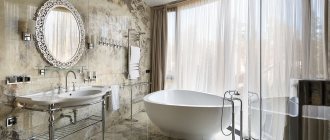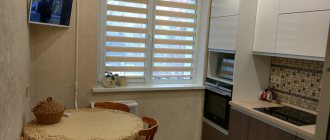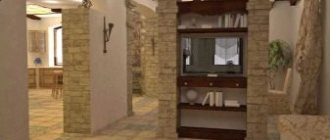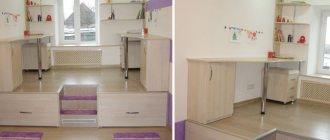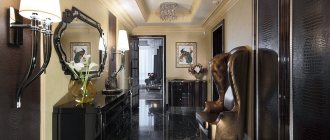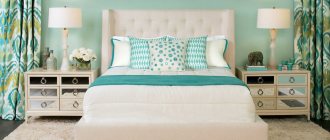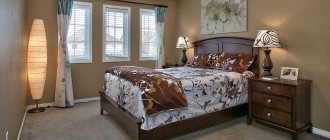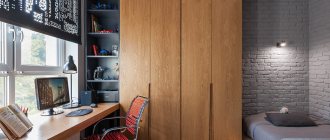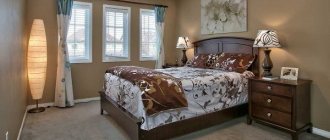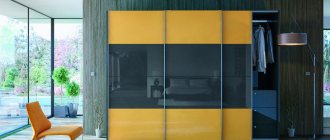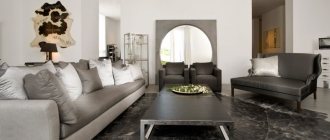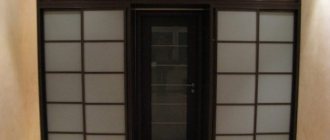Problems often arise with storage space for household chemicals. All sorts of powders, cleaners, rinses... There are more and more of them, but there is usually nowhere to store them. The bathroom is too humid, the kitchen is not very pleasant, as they can spread extraneous aromas, which do not combine well with cooking, or rather, do not combine at all. However, there is a way out - a closet in the toilet. Although the toilet is usually a small room, you can still find free space in it - above or behind the toilet. This is where you can hang/install the toilet cabinet.
Features of selection and location
A few things to choose from:
- The cabinet is selected according to the size of the room. For example, for a small toilet room in an apartment, small structures or narrow models located above the toilet are better suited.
- In a spacious toilet combined with a bathtub, you can install a larger hanging structure, a cabinet or a pencil case.
- You should not choose products that are too wide and will hang over your head. The most optimal and harmonious option are cabinets with a width of 20 cm.
- It is also undesirable to save on accessories and prefer high-quality and proven products.
Finishes and materials
The main rule for good design of a small toilet is to follow the rules that will help visually lengthen and expand the space thanks to individual elements.
Floor
A small area of the toilet can be covered with a single-color self-leveling floor, reminiscent of gloss, which, in combination with light, will give the room additional space. The ideal choice is 6 or 8-angled tiles with small patterns. Large drawings and bulky ornaments will make the toilet even narrower, so you should avoid them. The color scheme can be monochromatic, or it can combine two shades of the same color (cold and warm).
Walls
An original and practical type of wall covering for a small toilet can be plastic/wooden panels, glazed ceramics, vinyl wallpaper or decorative stone. In the design, you should give preference to calm shades (sand, beige, white, blue, gray), as well as zoning bright and neutral tones. For example, white with gray, black with white, green with light green. This simple move will also help visually expand the space.
Ceiling
One of the most successful options for a small toilet can be considered a suspended ceiling (PVC film). Among its subspecies you can find glossy, silk, matte, pearl. The main thing is not to forget that the high quality of the ceiling and the overall design of the toilet can only be appreciated in combination with good basic and additional lighting.
Types of toilet cabinets
There are a large number of lockers with different operational parameters and appearance.
Mounted
It is a universal solution for a miniature room, where it is most often located above the toilet. Such hanging furniture pieces on a mounting plate have a wide variety of sizes, depth, content and stylistic design.
The photo on the left shows a narrow wall cabinet above the cistern in the interior of a modern toilet.
Built-in
It has a fairly compact design, easily fits into the interior space and provides convenient access to the filling.
Floor
It is a free-standing model that can be equipped with legs, open or closed shelves.
Retractable
These multifunctional products allow you to save usable space and are therefore especially suitable for decorating a small toilet. Roll-out cabinets are often located near the toilet, which is very convenient.
Open shelves in the toilet
Such designs add special style and comfort to the environment and are mainly used to place various decor, for example, it can be a vase of flowers, wicker baskets, jars of cream or soap, etc.
The photo shows the interior of a toilet with wooden open shelves located above the toilet.
Rack
It is a compact and ergonomic furniture element that can add versatility to even the smallest room. Forged racks have a particularly impressive appearance; they are not only a beautiful and elegant product, but are also suitable for storing towels, napkins and other hygiene products.
Cabinet
Quite roomy and at the same time not occupying much space, the pencil case, thanks to the shelves installed along the entire length, allows you to place all the necessary household supplies inside.
The photo shows a pencil case made in white in the interior of the toilet.
With doors
This option has different sizes, installation methods and designs. Wardrobes with hinged or sliding doors perfectly hide all contents and help create a neat interior.
With roller shutters
It can be a model with roller doors, which is a practical option for a small room and allows you to save additional space, or a cabinet with louvered doors, which provides excellent ventilation for the internal contents.
Development of a design drawing
Any design, even the simplest one, needs detailed elaboration. Creating a drawing will allow you not to be distracted by calculations and correcting errors during work.
Detailed design drawing
First, you should draw several sketches, choosing the location of the cabinet, its interior space, and the design of the facade. Then it is necessary to measure the height of the room and the width of the free space behind the toilet so that it becomes clear what dimensions of the structure are acceptable in the existing conditions. The drawing shows the location of pipes and other communications, linking their position to the corner of the room.
Sketch drawing
Taking into account the data space obtained during the measurement, a detailed drawing is developed, which shows the location of the cabinet, communications and access to them, frame features, top and bottom covers, shelves, doors, places and methods of fastening individual elements.
The principle of fastening the frame and shelves
Note! Depending on the chosen design, its frame can be installed along the entire wall or above the barrel.
The width of a typical toilet varies between 820 – 850 mm, so the installation of shelves with cutouts for pipes (about 250 mm) occurs across the entire width of the room.
There are several door design options:
- Traditional swing doors require free space for opening.
- The sliding sash does not require free space.
- Roller shutters can be used as a shutter, the blade of which moves up and down along the side guides.
- The interior space can be closed with blinds or curtains.
Mirror swing doors
Purpose of the closet in the toilet
Main types of destination:
- Plumbing. Used to cover pipes, meters or boiler and thereby adds more attractiveness and neatness to the room. A plumbing hatch provides free access to communications or a water riser for repairs or cleaning. In addition, devices hidden in plasterboard, wood or plastic construction have a longer service life and accumulate less condensation and dust.
- Economic. It can be quite large in size and serve as a kind of storage room for a mop, broom, rags, buckets, basins or storage of other household items used in the household.
- Decorative. It performs an exclusively decorative function and may have a very interesting design, original color of the doors, a glossy or glass facade through which neatly placed decorations will be visible.
The photo shows the interior of a modern toilet with a utility cabinet under the sink.
The design with a specific purpose not only has a practical function, but also allows you to create a rather pleasant design.
The photo shows a decorative brown cabinet in the interior of the toilet.
Description and step-by-step instructions
Preparation
The only place in the toilet where you can place storage for various necessary items is the space behind the toilet.
It is small, and even occupied by plumbing fixtures, but with the right approach you can fit a fairly large cabinet here.
It will not “eat up” useful space, but in order to become truly useful it must satisfy specific requirements:
- minimum depth . The dimensions of the furniture should not interfere with the use of the toilet, and therefore cannot extend beyond the cistern;
- moisture resistance . The toilet belongs to a room with high humidity, and the proximity of the tank and pipes increases the risk of direct contact with water;
- the presence of ventilation holes to prevent the accumulation of fumes inside;
- ensuring free access to plumbing equipment . The area under consideration may contain cold and hot water pipes, valves, cleaning filters and other components. The cabinet should not block access to them, even if these nodes are used very rarely;
- attractive appearance.
According to the installation method, toilet cabinets are divided into built-in and wall-mounted (cabinet) types. In the first case, they fit between walls or in niches and are securely and permanently fixed. The cabinet cabinet is hung on the wall and is made as a separate, mobile piece of furniture. It can be moved and removed for a while.
Of what?
Materials for toilet furniture are selected taking into account the following requirements:
- sufficient mechanical strength;
- light weight;
- water resistance;
- external attractiveness;
- ease of processing during manufacture and cleaning during operation;
- environmental cleanliness.
If they do not have sufficient moisture resistance, then it becomes necessary to apply protective coatings or carry out special hydrophobic impregnation.
The following materials are most often used to make cabinets:
- drywall _ Waterproof varieties are suitable for toilet conditions. Drywall sheets are easy to process and are quite resistant to condensation and moisture and are not susceptible to rotting. The appearance is achieved by painting it in the desired colors. Disadvantages include low mechanical bending resistance, as well as fragility of corners and edges;
- plywood _ Modifications FC and FSF with increased water resistance are quite suitable for bathrooms. Usually sheets with a thickness of at least 14 mm are used. It should be noted that FSF type plywood contains phenol formaldehyde, which can be released from the material at elevated temperatures;
- wood _ In the manufacture of the frame, wooden beams are most often used. The board can also be used for doors. The main disadvantage is rotting under the influence of moisture, which requires impregnation of the material with special compounds;
- laminated chipboard (LDSP). Increased water resistance allows it to be used as shelves, doors and a wall-mounted case. When choosing this material, one should take into account its significant mass, which leads to deformation under the influence of its own weight. This circumstance requires the use of reinforcing elements (stiffeners);
- metal . When making a frame, an aluminum profile for attaching drywall or a metal corner is often used. The metal has high mechanical strength, but steel elements require reliable protection against corrosion;
- plastic _ Dense plastic panels are widely used as doors. A variety of colors makes it possible to provide the desired design. Important advantages are light weight and absolute waterproofness.
The choice of materials for toilet cabinets is made taking into account the chosen design, size, and design solutions.
Advice . The thickness should be optimal - provide the necessary strength, but not increase the weight excessively.
Scheme and drawing
Before you start making a cabinet, you need to think carefully about how it will be placed in a specific location. To do this, the space behind the toilet or installation is carefully measured, and a diagram of the location of plumbing units that must be accessible is drawn up. It is provided with special slots, holes, and hatches.
Based on the drawn up diagram, a drawing is developed with full detail and reference to the installation site. The design of the cabinet is quite simple - a frame, top and bottom panels, shelves and doors, and, if necessary, a false panel (back wall).
Advice . The frame can be installed on the entire wall behind the toilet or occupy only the space above it and the flush cistern.
A typical toilet in apartment buildings is often 82-85 cm wide . With this size, the outer panels and shelves are mounted across the entire width. Cutouts are made in them to allow pipes to pass through. The depth of the cabinet is determined by the distance of the tank from the wall. As a rule, it is 30-40 cm. In this case, the pipes require a cut-out up to 25 cm long .
Doors can be of several options. Most often, simple swing doors (2 pieces) are installed. You can use projects with sliding doors and roller shutters.
Tools
To make and install a cabinet in the toilet, you need to take care of the following tools in advance:
- perforator;
- Bulgarian;
- electric drill;
- screwdriver;
- electric jigsaw;
- plane;
- hacksaw;
- scissors and hacksaw for metal;
- hammer;
- chisels;
- pliers;
- paint brush.
To carry out measurements and quality control, you will need a building level, a plumb line, a tape measure, a metal ruler, and a square.
Manufacturing
In cramped toilets, the most popular option is a built-in cabinet . It is installed between the walls behind the toilet and covers the back wall. After developing the drawing and installation diagram, you can begin to manufacture and assemble this furniture. First of all, the installation site is carefully prepared. The walls must be thoroughly dried. Clean off all dirt and damaged coating. If necessary, the surface of the walls is leveled.
Advice . If there are areas with mold or mildew, they are thoroughly cleaned and treated with copper sulfate.
Frame above the toilet
The first step in installing a cabinet is marking the installation location . If the height of the cabinet reaches the ceiling, then the marking begins from its surface. The extreme points limiting the depth of the cabinet are marked. A plumb line is lowered from them to check the location relative to the boundaries of the cistern. The mark should not go beyond it. A line is drawn - the border of the front part. It must be strictly perpendicular to the side walls of the toilet.
Next, the walls are marked . The lowest point is set by moving away from the top of the tank to the distance necessary to service its handle during operation. A line parallel to the floor is drawn through this point.
Using a level, this marking is transferred to the opposite side so that both lines are at the same distance from the floor. Then, the location of the shelves inside the cabinet is marked on the walls.
If the height of the cabinet does not reach the ceiling, then all markings are provided on the walls. First, the lower boundaries are marked using the specified method.
After this, the required height of the cabinet is measured from them (according to the drawing) and lines are drawn strictly parallel to the bottom markings.
The most common design of a toilet cabinet frame is the lower and upper walls (panels), rigidly connected by vertical posts.
Advice . Most often, the frame is assembled separately, and then inserted into the wall and securely fastened.
Wooden beams measuring 30x30 mm or an aluminum profile can be used as racks . Rigid panels made of chipboard, planks or thick plywood can be directly fastened with racks. To make plasterboard panels, first, a frame is assembled from a metal profile, which is sheathed with a sheet of plasterboard.
Before assembling the frame, a section for joining with pipes is cut out in the bottom panel, and, if necessary, in the top wall. To do this, a slot is made with a width equal to the diameter of the pipe, the length of the distance between the line and the toilet wall. A semicircle is formed at the end of the slot to go around the pipe. This slot allows you to “put” the panel on the pipe so that its far edge reaches the wall surface. Their number on the panel depends on the number of highways.
The assembly of the frame when using beams is ensured by metal corners. If an aluminum profile is joined, then special metal screws are used. The assembled structure is checked for the verticality of the racks using a plumb line and the horizontality of the panels using a building level.
The cabinet frame is installed in the selected location, focusing on the markings. The frame posts are attached to the wall with dowels in increments of no more than 30 cm . To do this, before installation, appropriate holes are made in the wall using a hammer drill.
Important . If the walls of the bathroom are not perfectly vertical, then a gap will form between the counter and the wall surface. A gasket-seal should be placed in it, providing a more rigid fastening of the frame.
Shelves
Cabinet shelves are most often made of laminated chipboard, 15 mm thick waterproof plywood or boards .
Before installation, slots for pipes are made in them using the above method. The cuts are made at the corners to go around the vertical posts of the frame.
To install shelves between the frame posts, crossbars made of wooden beams or aluminum profiles are fixed to the wall according to the markings.
The ends of the shelves rest on these crossbars and are secured with self-tapping screws.
Doors
The highest demands are placed on toilet cabinet doors, because... They are the ones who create a certain appearance. The following methods of their manufacture are distinguished:
swing doors made of laminated chipboard .
2 identical doors are formed from a sheet of laminated chipboard. They are fastened using furniture hinges. To do this, 2 sockets for the hinge base are cut out on the back side of the sashes. The reverse parts of the hinge are fixed to the frame posts;- set doors .
They also feature a double-leaf, hinged design. Each sash is assembled from wooden slats or linings, which are tightly fitted to each other and glued together. For reliability, a reinforcing edging is made from an aluminum corner. Such sashes are usually installed on frame posts using ordinary hinges (“butterflies”); - paneled sashes . For them, a frame is first assembled from a wooden slat no more than 2 cm thick. Then, it is lined on both sides with plastic, thin plywood or moisture-resistant fiberboard. The doors are hung on regular, rotary hinges;
- lattice doors . Such doors not only look original in the toilet, but also provide ventilation for the cabinet. When making them, the frame is first assembled - wooden or plastic. Wooden or plastic slats are fixed parallel to it in the horizontal direction.
When securing door leaves, it is important to ensure their symmetry and strictly vertical location. There should be no gap between them.
Important . Opening should be easy, but not self-opening.
Decoration
The final stage of making a cabinet is giving it an attractive appearance.
It is enough to coat wooden doors with waterproof varnish in several layers. Alkyd-urethane varnish works well .
Before varnishing, you can provide tinting using stain or special compounds that emphasize the structure. Chipboard and drywall will have to be coated with a primer and then painted in the desired color.
Advice . The plastic itself provides the decor, and therefore you just need to choose it by color.
Fittings play an important role. To ensure that the doors are kept closed, magnetic elements are installed. A U-shaped aluminum or chrome profile, which is attached to the front edge, helps to give the shelves a decorative look.
Door handles should not only be comfortable, but also beautiful. Their range is huge, and therefore you need to choose taking into account the overall design (color, size and shape). Finally, you can use plastic moldings, which can give any surface an attractive look. In addition, it is advisable to cover the edges of the doors with decorative strips of plastic or metal. If you need to secure closed doors, you can install latches of the type you like.
Advice . If you need cabinets for other rooms, you can do the bathroom, hallway, balcony or kitchen.
Options for the location of cabinets in the bathroom
The most popular solutions.
Cabinet behind the toilet
A convenient cabinet behind the toilet provides an excellent storage system for toilet paper, towels, air freshener and other small items.
The photo shows a pop art style toilet with a cabinet located behind the toilet.
Thanks to this placement, it is possible to free up space on the cabinet with a sink or shelves, which can be decorated with other beautiful decor.
Above the installation
Such a solution will be an excellent addition to the toilet, which does not overload or clutter the room. This arrangement not only allows you to hide communications, but also provides enough space to fill with other necessary things.
The photo shows a cabinet with a mirrored door above the installation in the interior of the toilet.
Hidden
It is distinguished by a very aesthetic appearance and, due to the facade part, which harmonizes and merges with the walls in the interior, creates the feeling of a complete plane, behind which there is actually a secret closet with a lot of things. Quite often, when finishing a toilet with tiles, the doors of the hidden box are also decorated with identical cladding.
Side
It perfectly complements the decor and, due to its thin and light forms, does not overload the space. This piece of furniture may be left or right-handed.
The photo on the right shows the interior of a small toilet, decorated with a narrow floor cabinet with drawers.
Angular
It is considered the most suitable option for small toilet rooms, which can be located in any corner of the room. Two corner shelves installed on both sides of the toilet will look very organic.
In a niche
Such products are equipped only with shelves and doors, and the rear and side walls represent the niche itself.
The photo shows the interior of a toilet with an open cabinet with lighting built into a niche.
Open niches
In this case, the niche performs a decorative function. The relief of the uneven surface and the contour of the recess are emphasized by spot lighting.
Diversity in a monochrome interior is achieved through the play of light. Volumetric decor fills the recess in the wall and casts interesting shadows.
An open niche laconically complements the minimalism in space.
Design of a small toilet with a cabinet
A small toilet room is equipped with narrow shelves that take up space above the toilet barrel, or a side wall or mini-models, with open or closed shelves that look very harmonious and neat.
Quite often they use products with mirrored facades, which make it possible to visually increase the dimensions of the room. Such cabinets do not contribute to cluttering the space, give the atmosphere a special lightness and allow you to radically change the design of the room.
Other options
Wicker baskets are suitable not only for towels: your cat will appreciate such a house. If in principle it doesn’t bother you that she will watch you.
The geometry of the room gives ideas for design. In this case, open shelves are not only useful for household purposes, they also visually straighten the wall behind the toilet (suitable for crooked walls!).
Combined option - open and closed shelves.
A mirror-cabinet allows you to use the wall space to the maximum functionally.
The problem is not solved? See: Best Ways to Hide Pipes in a Toilet
How to decorate a locker?
In the color scheme for the cabinet, you can choose either delicate white, beige, blue pastel tones, perfect for a small toilet, or brighter and more contrasting green, red, black shades, which will form a catchy accent in the interior and thereby also create the appearance of additional space.
Models made of colored acrylic plastic or frosted, transparent glass look very interesting and original, as well as metal structures, especially often used for a loft-style toilet room.
Homemade cabinets or products decorated with drawings, 3D images or photo printing, which are suitable for a toilet in almost any style, have a rather unusual design. An even greater effect can be achieved by equipping the structure with lighting that automatically turns on when the doors are opened.
The photo shows a wall cabinet with a mirrored front in the interior of the toilet.
What material is it made from?
When you decide to make a closet for your toilet, the question immediately arises of what material to make it from. If we talk about furniture, there are the following options:
- laminated chipboard (LDSP);
- laminated MDF;
- wood.
Furniture for the toilet can be ordered from a furniture shop.
The cheapest material in this category is laminated chipboard. MDF is four times more expensive and wood is even more expensive. If you assemble doors from edged boards or lining with your own hands, it may not be more expensive than MDF. But such work requires at least minimal carpentry skills. If it is not there, you will have to pay for the work of a specialist, which can significantly increase the final cost of the product.
If you are going to cover the cabinet with tiles, wallpaper, vinyl, plastic, you can use materials other than those listed above:
- plywood;
- GVL (gypsum fiber sheet);
- OSB;
- sheet MDF.
All of the materials listed are quite suitable for constructing a cabinet in the toilet. The only doubt may be about the GVL: will it crumble at the place where the hinges are attached? If large loads are not expected, it is quite possible to use this material.
Frosted glass and mirror are also possible options for facades for a closet in the toilet
Now the question is whether it is worth using moisture-resistant materials. The closet for the toilet can be made of ordinary material, provided that it is only a toilet and not a combined bathroom, i.e. There will be no high humidity in the room. An exception is the situation when the ventilation of the bathroom is done using a flow window through the toilet. Such schemes still exist in houses with old layouts. In all other situations, the use of moisture-resistant materials is optional.
Lighting and decor
Many people think that the smaller the room, the fewer light sources are needed. This is wrong. One single lamp will not be able to cover all corners of the room. A good option is mini spotlights, which can be built into the center of the ceiling or along an extended row. Also, an LED strip for a mirror or floor lighting can become an additional stylish spotlight. Then the room will look small and cozy, and not narrow and gloomy.
Original and practical decorative elements for a small toilet can be unusual towel organizers, soap dishes, small lamps of non-standard shapes, mirrors and even plants that do not require too much light (cyperus, cactus, ficus).
more
What can you store in a locker?
Cabinets can differ in the types of their main purpose:
Plumbing, when it is used to close pipes along with a boiler or meter. The room with them looks neat and has a more attractive appearance. The hatch ensures accessibility of communications during the cleaning or repair process. Less dirt deposits accumulate on devices and they last longer;
A utility room, which can become an original storage room that can accommodate a mop, a broom, a bucket and many other useful things for the home;
Decorative, performing only aesthetic functions thanks to the original design of colored doors, facade glass or glossy surface, which will please the eye with the arrangement of decorations.
